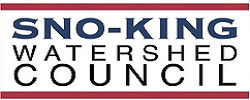What’s the problem with Stormwater?
Rain is a part of life in the Pacific Northwest . Stormwater runoff is rain (or snowmelt) that flows off developed land—such as roads, parking areas, rooftops and lawns—into nearby streams, rivers and Puget Sound . Runoff enters these waterbodies either directly or through drainage systems.
Check out this great infographic from King County! http://your.kingcounty.gov/dnrp/library/water-and-land/stormwater/surface-water-management-infographic.pdf
Stormwater runoff poses a high risk to the health of Puget Sound by causing two major problems.
First, stormwater transports a mixture of pollutants such as petroleum products, heavy metals, animal waste and sediments from construction sites, roads, highways, parking lots, lawns and other developed lands, with the following results:
- Stormwater pollution has harmed virtually all urban creeks, streams and rivers in Washington State.
- Stormwater is the leading contributor to water quality pollution of urban waterways in the state.
- Two species of salmon and bull tout are threatened with extinction under the federal Endangered Species Act. Loss of habitat due to stormwater and development is one of the causes.
- Shellfish harvest at many beaches is restricted or prohibited due to pollution. Stormwater runoff is often one of the causes.
- Stormwater likely contributes to the killing of high percentages of healthy coho salmon in Seattle creeks within hours of the fish entering the creeks, before the fish are able to spawn.
- English sole are more likely to develop cancerous lesions on their livers in more urban areas. Stormwater likely plays a role.
Second, during the wet, winter months, high stormwater flows, especially long-lasting high flows, can:
- Cause flooding.
- Damage property.
- Harm and render unusable fish and wildlife habitat by eroding stream banks, widening stream channels, depositing excessive sediment and altering natural streams and wetlands.
In addition, more impervious surface area means less water soaks into the ground. As a result,drinking water supplies are not replenished and streams and wetlands are not recharged. This can lead to water shortages for people and inadequate stream flows and wetland water levels for fish and other wildlife.

![Storm_Water_16x9[1]](http://snokingwatershedcouncil.org/wp-content/uploads/2013/12/Storm_Water_16x91.jpg)